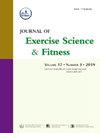两种不同剂量的HIFT对轻度认知障碍老年人身体功能、认知表现和生活质量的影响:一项随机对照试验
IF 2.4
2区 医学
Q2 SPORT SCIENCES
引用次数: 0
摘要
背景/目的:轻度认知障碍(MCI)损害老年人的身心功能,并增加痴呆的风险。高强度功能训练(High-Intensity Functional Training, HIFT)是一种很有前景的干预手段,但在这一人群中,改善认知和身体状况的最佳剂量反应尚不清楚。方法对224名年龄≥65岁的老年人进行随机对照试验,将其分为3组:高剂量HIFT组(4次60分钟/周)、低剂量HIFT组(2次45分钟/周)和对照组(无运动活动)。干预持续12周。主要指标包括认知功能(MAAS、MoCA、TMT A/B、VFAT、DSST)、体能(Senior fitness Test、Tinetti)和生活质量(SF-36、PSQI)。采用重复测量方差分析来检验时间×组相互作用。结果MAAS (F = 20.50; p < 0.001; η2G = 0.005)、MoCA (F = 17.40; p < 0.001; η2G = 0.034)、TMT A (F = 38.60; p < 0.001; η2G = 0.098)和VFAT (F = 109.00; p < 0.001; η2G = 0.101)的时间组间相互作用显著,HIFT组与对照组相比均有较大改善。对于生活质量,在SF-36的所有维度中都发现了显著的相互作用,特别是在活力(F = 76.20; p < 0.001; η2G = 0.095)和情感角色(F = 23.00; p < 0.001; η2G = 0.032)。身体素质也得到了改善,在6分钟步行测试(F = 29.80; p < 0.001; η2G = 0.108)和8英尺上下行走测试(F = 81.00; p < 0.001; η2G = 0.191)中效果显著。结论:高剂量和低剂量HIFT方案均可改善老年MCI患者的认知、身体和生活质量。低剂量干预取得了与高剂量方案相似的效果,为在临床和社区环境中实施提供了一种具有时间效率和可扩展的方法。本文章由计算机程序翻译,如有差异,请以英文原文为准。
Effects of two different doses of HIFT on physical function, cognitive performance, and quality of life in older adults with mild cognitive impairment: A randomized controlled trial
Background/Objective: Mild cognitive impairment (MCI) compromises physical and mental function in older adults and increases the risk of dementia. High-Intensity Functional Training (HIFT) is a promising intervention, but the optimal dose-response for improving cognitive and physical outcomes in this population remains unclear.
Methods
A randomized controlled trial was conducted with 224 older adults (≥65 years) allocated to three groups: high-dose HIFT (4 sessions of 60 min/week), low-dose HIFT (2 sessions of 45 min/week), and control (non-exercise activities). The intervention lasted 12 weeks. Primary outcomes included cognitive function (MAAS, MoCA, TMT A/B, VFAT, DSST), physical fitness (Senior Fitness Test, Tinetti), and quality of life (SF-36, PSQI). A repeated-measures ANOVA was used to examine the time × group interaction.
Results
Significant time × group interactions were observed for MAAS (F = 20.50; p < 0.001; η2G = 0.005), MoCA (F = 17.40; p < 0.001; η2G = 0.034), TMT A (F = 38.60; p < 0.001; η2G = 0.098), and VFAT (F = 109.00; p < 0.001; η2G = 0.101), with greater improvements in both HIFT groups compared to control. For quality of life, significant interactions were found across all SF-36 dimensions, notably in Vitality (F = 76.20; p < 0.001; η2G = 0.095) and Emotional Role (F = 23.00; p < 0.001; η2G = 0.032). Physical fitness also improved, with significant effects in the 6-Minute Walk Test (F = 29.80; p < 0.001; η2G = 0.108) and 8-Foot Up-and-Go (F = 81.00; p < 0.001; η2G = 0.191).
Conclusion
Both high- and low-dose HIFT programs improved cognitive, physical, and quality-of-life outcomes in older adults with MCI. The low-dose intervention achieved similar effects to the high-dose protocol, offering a time-efficient and scalable approach for implementation in clinical and community settings.
求助全文
通过发布文献求助,成功后即可免费获取论文全文。
去求助
来源期刊
CiteScore
5.10
自引率
3.60%
发文量
54
审稿时长
31 days
期刊介绍:
The Journal of Exercise Science and Fitness is the official peer-reviewed journal of The Society of Chinese Scholars on Exercise Physiology and Fitness (SCSEPF), the Physical Fitness Association of Hong Kong, China (HKPFA), and the Hong Kong Association of Sports Medicine and Sports Science (HKASMSS). It is published twice a year, in June and December, by Elsevier.
The Journal accepts original investigations, comprehensive reviews, case studies and short communications on current topics in exercise science, physical fitness and physical education.

 求助内容:
求助内容: 应助结果提醒方式:
应助结果提醒方式:


